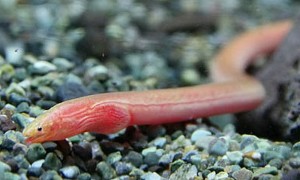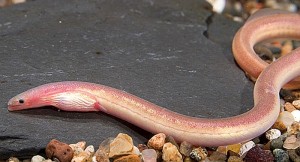The Purple Spaghetti Eel (Moringua raitaborua) is an extremely rare member of the moringua family that is found in the Gangetic estuary (West Bengal) in India, Matla and Bidyadhari river, and probably Bangladesh, Indonesia, and the Philippines. They are also known to tropical fish keeping enthusiasts as the Pink Paddletail Eel, Purple Spaghetti Eel, Spaghetti Eel, and Paddle tailed Eel.
The Purple Spaghetti Eel is found in freshwater, brackish water and saltwater. As juveniles they are found in freshwater, and as they grow they move into brackish water and possibly salt water as adults.
They are most often found burrowed in the soft substrate of the underflow areas of rivers and estuaries where they feed on insects, crustaceans, various larvae, and small fish.
The Purple Spaghetti Eel (Moringua raitaborua) is a shy “worm eel” that grows to over 17 inches in length and has a thin (spaghetti like) appearance. They are colored pinkish to a purplish brown and have a paddle tail type anal fin.
Their dorsal and anal fins are located towards the back end of the eel, but they look more like folds than fins. They join with the caudal fin giving the eel their paddle type appearance. Mature females normally have deeper bodies than the males. Although they are carnivores, these eels have a small head and mouth and present no threat to most tank mates in an aquarium environment. Avoid housing them with small species such as neons, guppies, or livebearer fry, and larger more aggressive eels.
Purple Spaghetti Eels should be housed in at least a 30 gallon tank with low subdued lighting and a sandy substrate so they can bury themselves.
They need plenty of hiding places so rocks, roots, and plants can also be used for aquascaping to help them feel secure. Unfortunately, they are extremely shy and will remain buried head first in the sand most of the time.
Because these eels can worm their way through very small openings, a tight fitting lid is a must. Also, it’s a good idea to cover the intakes of your pumps or powerheads with sponge material to prevent them from getting into the impellers.
Purple Spaghetti Eels do best in highly oxygenated, soft, slightly acidic water, with a moderate amount of water movement and exceptionally good filtration. Ideally, the water in the tank should be turned over at least 10 to 15 times per hour and an under gravel filter for these fish is an excellent choice for reducing waste and creating a high oxygen level throughout the system. Weekly water changes of about 20% to 30% are a must for this species.
A canister filter will provide sufficient water flow and oxygenation, or you can substitute a couple of powerheads and airstones in lieu of using a canister filter.
Because Purple Spaghetti Eels are a brackish water species, they need extremely pristine water conditions to survive long term. Although they have been kept in fresh water for short periods of time, they do best when the specific gravity is kept at a level of 1.005 to 1.010.
The Purple Spaghetti Eel has never been bred in an aquarium environment.
In it’s natural environment, the Purple spaghetti Eel is a nocturnal predator of benthic invertebrates and small fish. Insect larvae, small worms, and crustaceans comprise their primary diet. In an aquarium environment they can be fed live or frozen tubifex, bloodworms, or brine shrimp with an occasional “treat” of livebearer fry when available. Feed them daily towards evening.
Poor water quality can cause fungus problems with these eels, but do not use copper based medications on these fish.
The Purple spaghetti Eel is rarely if ever available to tropical fish keeping enthusiasts and on the rare occasion when they are available, command a high price.
Minimum Tank Size: 30 gallons
Care Level: Difficult
Temperament: Shy, Peaceful
Aquarium Hardiness: Difficult to maintain
Water Conditions: 72-78° F, KH 8-12, pH 8.1-8.4
Salinity: 1.005 to 1.010 as adults
Size: 18″
Color Form: Pink, Purple
Diet: Carnivore
Compatibility: Multiple species brackish water tank
Origin: India
Family: Moringuidae
Life Span: 5-12 years
Aquarist Experience Level: Advanced






